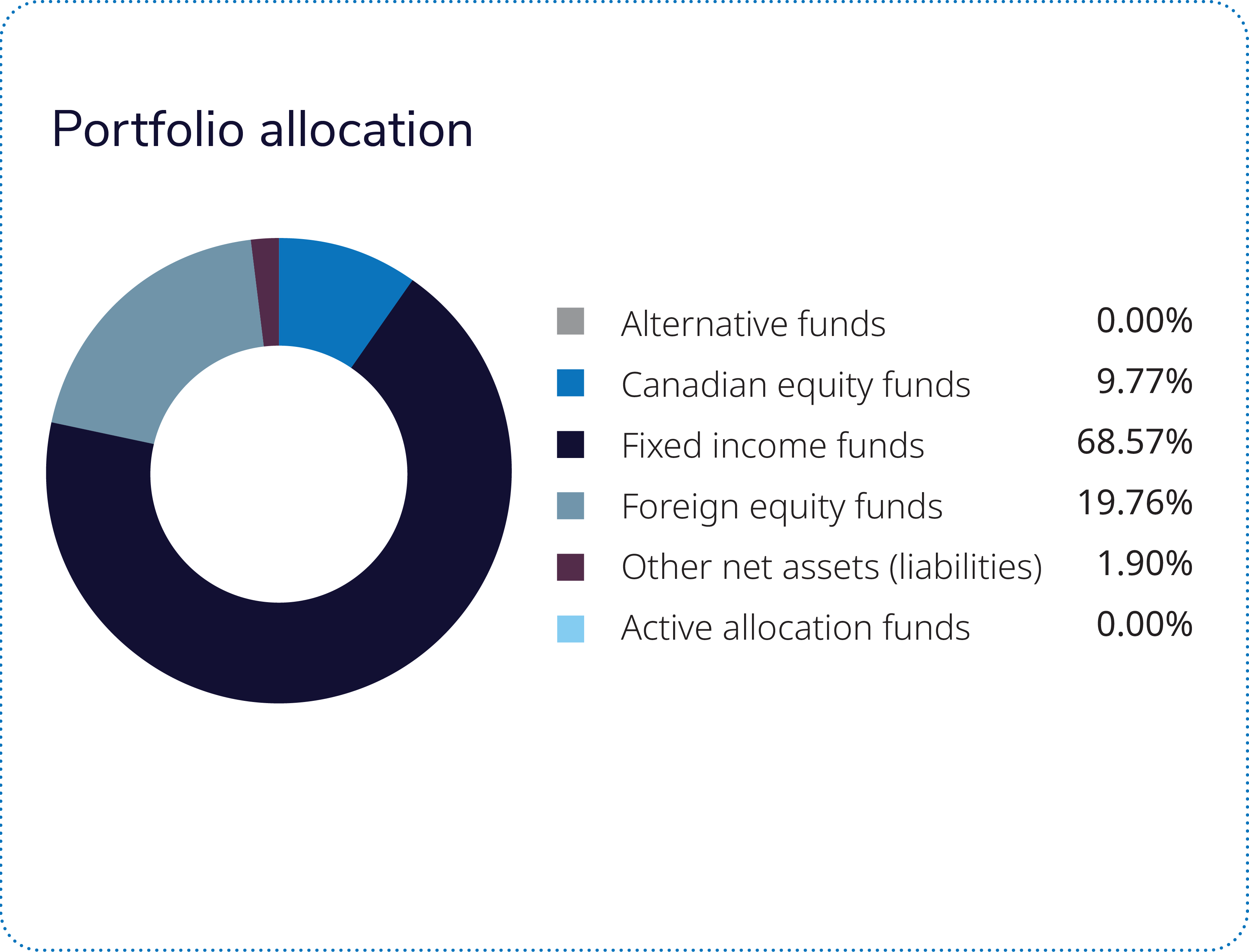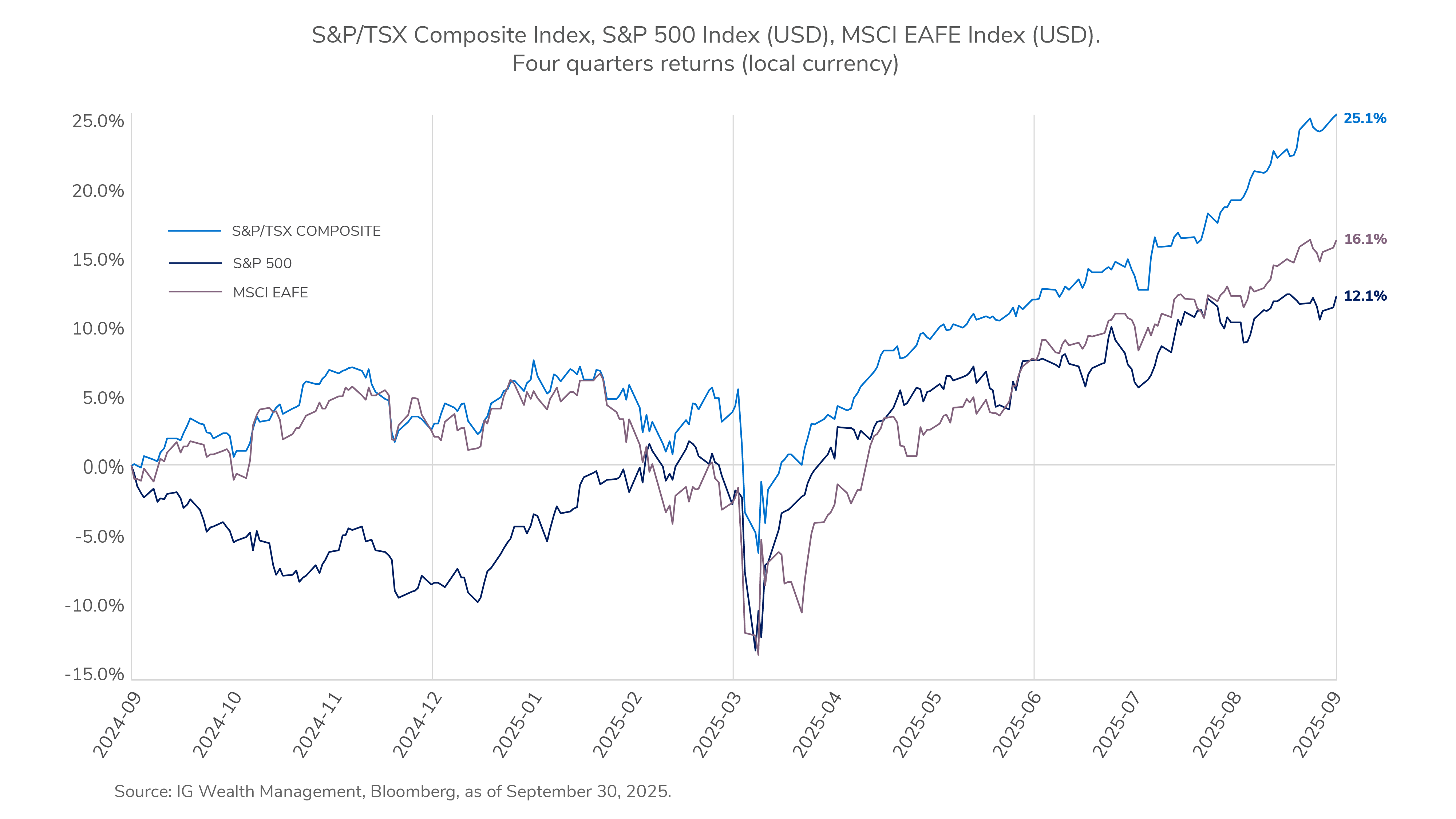Portfolio returns: Q3 2025
| Total Return | 1M | 3M | YTD | 1YR | 3YR | 5YR | 10YR | Since Inc. (Apr 19, 2022) |
IG Mackenzie U.S. Dollar Fund – Global Fixed Income Balanced F | 2.27
| 3.77
| 7.78
| 7.44
| 9.45
| 6.01
| ||
Quartile rankings | 1 | 1 | 4 | 1 | 2 |
Proudly Canadian
| Total Return | 1M | 3M | YTD | 1YR | 3YR | 5YR | 10YR | Since Inc. (Apr 19, 2022) |
IG Mackenzie U.S. Dollar Fund – Global Fixed Income Balanced F | 2.27
| 3.77
| 7.78
| 7.44
| 9.45
| 6.01
| ||
Quartile rankings | 1 | 1 | 4 | 1 | 2 |
 The IG Mackenzie U.S. Dollar Fund – Global Fixed Income Balanced generated a positive return and outperformed its benchmark, benefiting from a strong fixed income performance.
The IG Mackenzie U.S. Dollar Fund – Global Fixed Income Balanced generated a positive return and outperformed its benchmark, benefiting from a strong fixed income performance.
Global markets advanced in Q3 2025, fuelled by strength in AI-related stocks, easing trade tensions and central bank rate cuts. The U.S. Federal Reserve and Bank of Canada each cut rates by 25 basis points (a quarter of a percentage point), citing slowing job growth. U.S. equities hit record highs, led by AI-related and small-cap stocks. Canadian markets benefited from strength in the materials, information technology and energy sectors. Emerging markets surged, supported by Chinese technology stocks. Gold rallied to historic highs, while oil prices dipped on soft demand and rising supply. Bond markets posted modest gains; high-yield bonds outperformed investment-grade bonds, and emerging-market bonds also benefited from a softer U.S. dollar.
Within this economic and market backdrop, the fund’s global equity mandate, representing 30% of the portfolio, delivered a positive local return but lagged its benchmark. Gains were driven by the information technology and materials sectors. Relative to benchmark, stock selection in the health care sector added value, while selection in the financials and information and technology sectors detracted from performance.
Representing a 41% fixed income allocation, the Mackenzie Canadian Strategic Fixed Income ETF posted a positive return in local terms and outperformed its benchmark. The fund benefited from bond selection in government issues, and corporate energy and financials sectors. An overweight to corporate bonds also added value.
The Mackenzie Core Plus Global Fixed Income ETF, which has a 29% allocation, produced a positive return and outperformed its benchmark. Selection in government bonds added value, while an underweight to corporate bonds modestly detracted from relative performance.
The fund’s foreign currency hedging policy added value, offsetting foreign currency losses from a stronger U.S. dollar during Q3 2025.
The third quarter delivered broad gains across asset classes, with market performance largely overriding a backdrop of cautious sentiment. Investors looked past persistent trade policy headlines, increasingly treating the U.S. administration's tariff policy as noise rather than a core risk. The primary catalysts for the positive performance were a subtle shift toward lower-interest-rate expectations and resilient corporate earnings.
Signals from the U.S. Federal Reserve of imminent rate cuts were followed by a quarter percentage cut in September. Government bond yields eased into the quarter's end, supporting bond prices, while corporate bonds outperformed government bonds.

We remain moderately cautious as regards global equities. Valuations are elevated relative to macro risks, and U.S. stocks appear stretched after a strong run, with earnings revisions turning lower. International equities continue to offer a more attractive risk-return profile.
Ongoing U.S. tariffs are expected to pressure Canada’s economy and currency. A Canadian recession is increasingly likely, which would prompt the Bank of Canada to cut rates below 2% by year-end. In contrast to the U.S., which is likely to suffer from both a growth and an inflation shock, prices are not as much of a concern in Canada. The Bank of Canada has more flexibility to cut rates without fear of an inflation spike. Other developed-market currencies (the U.S. dollar, Japanese yen, euro and pound) are preferred over the Canadian dollar.
Commissions, fees and expenses may be associated with mutual fund investments. Read the prospectus and speak to an IG Advisor before investing. The rate of return is the historical annual compounded total return as of September 30, 2025, including changes in value and reinvestment of all dividends or distributions. It does not take into account sales, redemption, distribution, optional charges or income taxes payable by any securityholder that would have reduced returns. Mutual funds are not guaranteed, values change frequently and past performance may not be repeated. Mutual funds and investment products and services are offered through the Mutual Fund Division of IG Wealth Management Inc. (in Quebec, a firm in financial planning). And additional investment products and brokerage services are offered through the Investment Dealer, IG Wealth Management Inc. (in Quebec, a firm in financial planning), a member of the Canadian Investor Protection Fund.
This commentary may contain forward-looking information which reflects our or third-party current expectations or forecasts of future events. Forward-looking information is inherently subject to, among other things, risks, uncertainties and assumptions that could cause actual results to differ materially from those expressed herein. These risks, uncertainties and assumptions include, without limitation, general economic, political and market factors, interest and foreign exchange rates, the volatility of equity and capital markets, business competition, technological change, changes in government regulations, changes in tax laws, unexpected judicial or regulatory proceedings and catastrophic events. Please consider these and other factors carefully and do not place undue reliance on forward-looking information. The forward-looking information contained herein is current only as of September 30, 2025. There should be no expectation that such information will in all circumstances be updated, supplemented or revised whether as a result of new information, changing circumstances, future events or otherwise.
This commentary is published by IG Wealth Management. It represents the views of our Portfolio Managers and is provided as a general source of information. It is not intended to provide investment advice or as an endorsement of any investment. Some of the securities mentioned may be owned by IG Wealth Management or its mutual funds, or by portfolios managed by our external advisors. Every effort has been made to ensure that the material contained in the commentary is accurate at the time of publication, however, IG Wealth Management cannot guarantee the accuracy or the completeness of such material and accepts no responsibility for any loss arising from any use of or reliance on the information contained herein.
Trademarks, including IG Wealth Management and IG Private Wealth Management, are owned by IGM Financial Inc. and licensed to subsidiary corporations.
©2025 IGWM Inc.